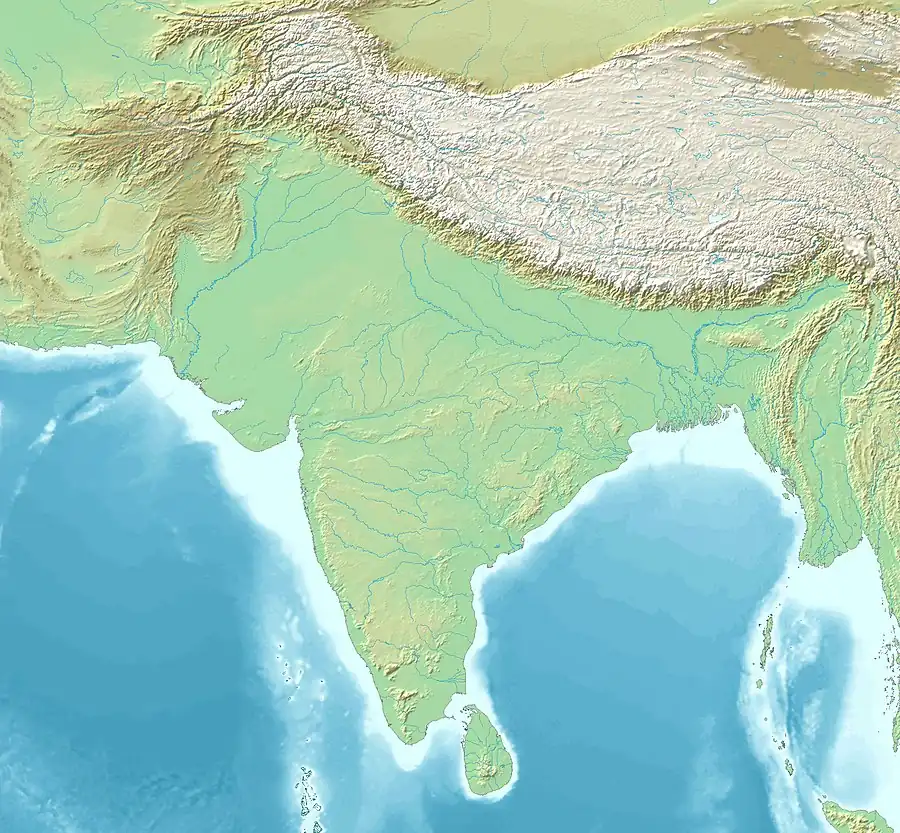| Battle of Salher | |||||||||
|---|---|---|---|---|---|---|---|---|---|
| Part of Imperial Maratha Conquests | |||||||||
| |||||||||
| Belligerents | |||||||||
|
|
| ||||||||
| Commanders and leaders | |||||||||
|
|
| ||||||||
 Location within South Asia | |||||||||
The Battle of Salher was a battle fought between the Marathas and the Mughal Empire in February 1672 CE. The battle was fought near the fort of Salher in modern day Nashik district. The result was a decisive victory for the Marathas. This battle is considered particularly significant as it is the first pitched battle where the Mughal Empire lost to the Marathas.
Background
The Treaty of Purandar (1665) required Shivaji to cede 23 forts to the Mughals. Strategically important forts, which were fortified with garrisons, such as Sinhagad, Purandar, Lohagad, Karnala, and Mahuli were turned over to the Mughal empire. At the time of this treaty, the Nashik region, that contained the forts Salher and Mulher, was firmly in the Mughal Empire's hands since 1636. The signing of this treaty resulted in Shivaji's visit to Agra and, after his escape from there in September 1666, two years of uneasy truce followed.[1]
The period between 1670 and 1672 saw a dramatic rise in Shivaji's power and territory. Shivaji's armies successfully conducted raids at Baglan, Khandesh, and Surat and retook more than a dozen forts. This culminated with a decisive victory against a Mughal army of more than 40,000 on an open field near Salher.
The battle
Senapati Prataprao Gujar and along with his army of 15,000 captured the Mughal forts Aundha, Patta, Trimbak and attacked Salher and Mulher in January 1671. This led Aurangzeb to send two of his generals Ikhlas Khan and Bahlol Khan along with 12,000 horsemen to reclaim Salher. In October 1671, the Mughal Army laid siege to Salher. In return Shivaji ordered his two commanders Peshwa Moropant Pingle and Prataprao Gujar to reclaim the fort.[2]
50,000 Mughals had besieged the fort for more than six months. Shivaji knew the strategic importance of Salher as it was the main fort on important trade routes. Dilerkhan had also attacked Pune in the meanwhile and Shivaji could not save Pune because his main armies were away. Shivaji devised a plan to divert Dilerkhan by forcing him reach Salher. He ordered Moropant who was in South Konkan and Prataprao who was raiding near Aurangabad to meet and attack Mughals at Salher to relieve the fort. In his letter to his commanders Shivaji had written 'Go to the north and attack Salher and defeat the enemy'.[3]
The battle lasted for an entire day and it is estimated that around 10,000 men were killed on both sides.[4] The Mughal military machines (consisting of cavalry, infantry, and artillery) were outmatched by the light cavalry of the Marathas.[5] The Mughal armies were completely routed and the Marathas gave them a crushing defeat.[6][7] 6,000 horses, an equal number of camels, 125 elephants, and an entire Mughal train were captured by the victorious Maratha Army.[1] Other than this, a large amount of goods, treasures, gold, jewels, clothes, and carpets were seized by the Marathas.
Outcome
The battle resulted in a decisive Maratha victory which resulted in the liberation of Salher. Further, the nearby fort of Mulher was also taken from the Mughals as a consequence of this battle. 22 wazirs of note were taken as prisoners and Ikhlas Khan and Bahlol Khan were captured. Among the Mughal soldiers who were prisoners around one or two thousand escaped. The notable Panchazari Sardar of the Maratha Army Suryajirao Kakade was killed in this battle and was revered for his ferocity during the battle. Approximately a dozen Maratha sardars were gifted for their remarkable achievements in the battle and the two officers (Sardar Moropant Pingle and Sardar Prataprao Gujar) were specially rewarded.
Consequences
Most of Shivaji's victories until this battle had been through guerilla warfare, but the Maratha's use of light cavalry on the Salher battlefield against the apparently superior Mughal forces proved effective.[5] This grand victory resulted in Saint Ramdas writing his famous letter to Shivaji in which he addresses him as Gajpati (Lord of Elephants), Haypati (Lord of Cavalry), Gadpati (Lord of Forts), and Jalpati (Master of the High Seas).[8] Although not as a direct outcome of this battle, a couple of years later in 1674, Shivaji was crowned the Chhatrapati of his realm.
See also
References
- 1 2 Pradeep Barua (2005). The State at War in South Asia. University of Nebraska. p. 42. ISBN 0803213441.
- ↑ Verinder Grover (1996). Mahadev Govind Ranade, Volume 3. Deep & Deep Publications. p. 199. ISBN 9788171002450.
- ↑ Jadhav, Namdeorao. Ganimi Kava.
- ↑ H. S. Sardesai (2002). Shivaji, the Great Maratha, Volume 2. Cosmo Publications. p. 366. ISBN 9788177552867.
- 1 2 Y.G. Bhave (2000). From the Death of Shivaji to the Death of Aurangzeb. Northern Book Centre. p. 42. ISBN 9788172111007.
- ↑ Y.G. Bhave (2000). From the Death of Shivaji to the Death of Aurangzeb. Northern Book Centre. p. 27. ISBN 9788172111007.
- ↑ Jaswant Lal Mehta (1981). Advanced Study in the History of Medieval India: 1526-1707. Sterling. p. 404. ISBN 9788120706170.
- ↑ Kincaid, Dennis (January 0101). The Grand Rebel. Prabhat Prakashan. p. 172.